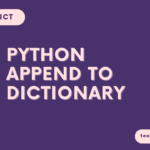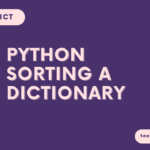Dictionaries are data structures that store key-value pairs. Often, in Python programs, you need to convert these dictionaries into JSON (JavaScript Object Notation) format sometimes for data storage, serialization, or communication with web services. Out of these, JSON is a lightweight and human-readable data interchange format. So, in this tutorial, we’ll explore different methods to convert Python dictionaries into JSON. In the end, we’ll also give a comparison to help you choose the most suitable method for your needs.
Converting a Python Dictionary to JSON
As we have said converting between Python dictionaries and JSON is a common programming task. And, for this purpose, Python standard library has a json module that makes it easy to do this.
1. Using the json Module
Python provides the built-in json module for working with JSON data. The most basic method in this module is json.dumps(data) for encoding and decoding JSON data.
The following Python code puts forth the simple steps to convert a dictionary to JSON.
import json
# Sample dictionary
data = {"name": "John", "age": 30, "city": "New York"}
# Convert dictionary to JSON
json_data = json.dumps(data)
print(json_data)In this example, we import the json module, define a dictionary data, and then use json.dumps() to convert it to a JSON string.
2. Using the json.dumps() with parameters
The json.dumps() method can help you customize the conversion process using various parameters:
import json
# Sample dictionary
data = {"name": "Ella", "score": 95}
# Customize the conversion
json_data = json.dumps(data, indent=4, separators=(",", ": "), sort_keys=True)
print(json_data)In this example, we use the indent, separators, and sort_keys parameters to control the formatting of the JSON output.
3. Using the json.dump() Method
The json.dump() method is used to write JSON data directly to a file-like object. This is useful when you want to save JSON data to a file:
import json
# Sample dictionary
data = {"country": "Canada", "population": 38000000}
# Write JSON data to a file
with open("data.json", "w") as json_file:
json.dump(data, json_file)In this example, we open a file named “data.json” in write mode and use json.dump() to write the dictionary to the file.
Also Read: Append to Python Dictionary
4. Custom function to convert a Python dictionary to JSON
If you need more control over the conversion process, you can create a custom function to convert a dictionary to JSON. This allows you to handle complex data types or apply specific logic during the conversion:
import json
def custom_dict_to_json(dct):
# Custom conversion logic
return json.dumps(dct)
# Sample dictionary
data = {"colors": ["red", "blue", "green"], "shapes": {"circle": 3, "square": 5}}
# Convert using the custom function
json_data = custom_dict_to_json(data)
print(json_data)In this example, we define the custom_dict_to_json function to handle the conversion of the dictionary data in a custom way.
5. Comparison and recommendation
To summarize, let’s compare the methods for converting a Python dictionary to JSON:
| Method | Advantages | Limitations |
|---|---|---|
json.dumps() | – Simple and built-in | – Limited control over file handling |
json.dump() | – Directly writes to a file | – Requires file I/O operations |
| Custom Function | – Full customization of conversion logic | – Requires manual implementation |
The following are some recommendations for converting the dictionary to JSON in Python.
- If you need a simple and quick conversion of a dictionary to JSON, use
json.dumps(). - Use
json.dump()when you want to save JSON data to a file. - If you require complex customization during conversion, create a custom function.
6. Working with nested dictionaries
In most cases, JSON has a deep hierarchical structure. This means that it will have many nodes which will further have child nodes. So, it is important to take an example of such a case. However, you can still use the methods discussed earlier. Here’s an example:
import json
# Sample nested dictionary
nested_data = {
"person": {
"name": "Eva",
"address": {
"city": "San Francisco",
"zipcode": "94101"
}
}
}
# Convert to JSON
json_data = json.dumps(nested_data, indent=2)
print(json_data)As you can see the json module handles nested dictionaries seamlessly.
7. Handling complex data types
JSON supports basic data types such as strings, numbers, booleans, arrays, and objects. However, you may encounter complex data types like Python date-time objects or custom classes in your Python dictionaries. To handle these, you can use custom serialization methods or libraries like datetime or pickle for more advanced data types.
8. Decoding JSON: Converting JSON back to Python dictionary
Converting JSON back to a Python dictionary is also straightforward using the json.loads() method. This function takes a JSON string as input and returns a Python object as output.
Here is an example of how to convert JSON to a Python dictionary:
import json
# JSON string
json_data = '{"name": "Bob", "age": 25, "city": "Chicago"}'
# Convert JSON to dictionary
python_dict = json.loads(json_data)
print(python_dict)9. Best Practices for Working with JSON
When working with JSON in Python, consider these best practices:
– Always validate JSON data to ensure it’s well-formed before decoding.
– Handle exceptions and errors when working with JSON to prevent crashes.
– Use meaningful keys and values in your dictionaries for better readability.
– Document the structure of your JSON data to facilitate collaboration with others.
Also Try: Convert a Python Dictionary to DataFrame
Conclusion – Converting a Python dictionary to JSON
In this tutorial, we explored different methods to convert Python dictionaries into JSON format using the json module, json.dumps(), json.dump(), and a custom function. Each method has its advantages and limitations, so you can select the one that suits your needs best. Whether you need a quick conversion, file output, or full customization, Python provides the tools to efficiently work with JSON data.









